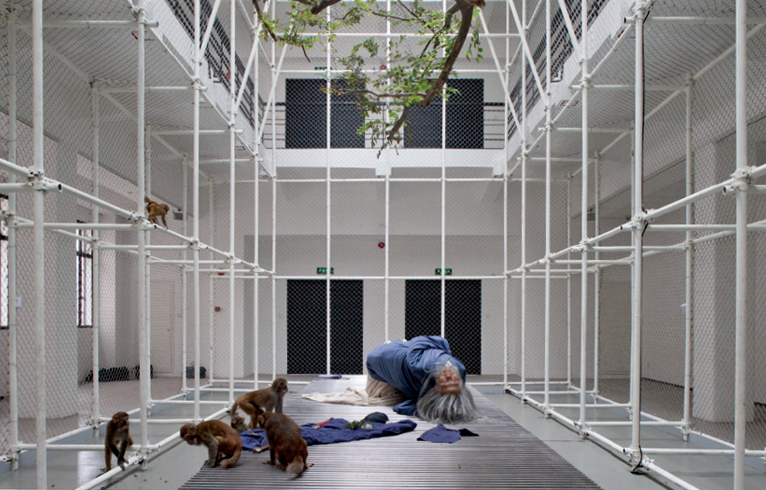ZHANG HUAN: Q CONFUCIUS
| February 20, 2012 | Post In LEAP 12

“You think you can just ask Confucius?” A group of his inquisitive pupils once said, and not un-rightly. It is therefore likely that Zhang Huan’s “Question” seeks to lead the viewer in proceeding from “Confucius” as symbolic subject, discovering new facets to this signifying symbol, catching glimpses of the relationships between Confucius and the self and Confucius and the Other, and in examining the possibility of this symbol’s vitiation and universality down the never-ending axis of time and space.
Mainstream depictions of Confucius tend to portray him as a wizened master of the old school. But Zhang Huan takes a different tack. In the middle of the space sits an enormous sculptural reproduction of the famously unattributed Ming-era painting Confucius at Ease, which lays before the viewer the bare flesh of Confucius’s upper torso. Its most essential aspect is its portrayal of a Confucius distinct from the idol of conventional experience: Confucius down on his luck, betraying his exhaustion, a weariness like that of “a dog without a home,” born from his fruitless travels as a wandering advisor to the princes of the age. This Confucius hangs his head, front teeth flashing from behind his lips. His pores are like pumice stone, his skin dotted with age spots. He floats on a wan pool of water, his gaze fixed firmly within, as if questioning himself. Here, Confucius is both the subject and object of “Question.”
Then there are the two works made from the ashes of joss sticks, each roughly the same size and each clearly intended both to query and to supplement its counterpart. Into the works Zhang places Jesus and Confucius, each “master” in an entirely different setting: Confucius closely surrounded by his students, Jesus and his disciples arrayed along a horizontal line. In the former, the remnants of religious worship hint at the mad scramble of untold generations of followers to venerate their sage. In these blurry, ashen faces, we see the entry of generations of acolytes into the monotony of the academy, each generation following the last like waves on the ocean, one wave indistinguishable from the next. It is, in the final analysis, a vestigial, drab existence.
On the outside of the exhibition space a temporary room has been constructed, housing an ancient tree under assault by a termite colony. The tree’s trunk suffuses the room with a smell like animal hide, concealing the termite hordes in its darkened interior. On the outside of the trunk march swift columns of black ants, bearing the bodies of their brothers. Zhang Huan sees a ritual order of sorts in termite society, a system passed from one generation to the next. There may, perhaps, be a subtly implied message for today’s society: is a country that worships ritual, yet thrives in the dark, truly incapable of giving rise to dark devices of its own? And, should this be true, is a polite inquiry or two from an external party really enough to shake this kingdom from its perfectly organized ritual? This questioning, be it for improvement, solution, or even revolution, is thus clearly “counter-evolutionary” activity. Alas, does one question, or does one prostrate oneself before this society and its mania for order?
Ask Confucius… but wasn’t it Confucius who said, “The gentleman speaks slowly, but acts decisively?” Ask Confucius… but why is it that the only “Confucius” in evidence is a shallowly understood, down-on-his-luck old man? For example: the various images of the sage formed from animal hide; or the solitary, white-haired, animatronic Confucius, his mind seemingly lost; or the “real” Confucius, an actual man dressed in scholarly robes, wandering around the exhibition with a downcast expression, spooking spectators. Why is it that we don’t hear from the Confucius who approved of expressions of life’s beauty? This Confucius— his heart light, his thoughts without guile— might provide us with another perspective entirely. Yuan Jing (Translated by Matthew Schrader)

